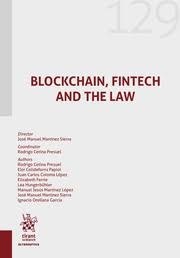

Formato papel
[Disponible. 3-7 días]
antes:
55,00 €
ahora:
52,25 €
Index
Introduction 13
Jose Manuel Martínez Sierra
How Blockchains and Smart Contracts have Changed
How we Do Business: Legal Perspectives
José Manuel Martínez Sierra
Juan Carlos Coloma López
I. Introduction 21
II. Distributed Systems and Blockchain Definition 23
A. Precursors and Properties of Distributed Systems 24
1. Consensus Algorithms 34
2. Classical Consensus Algorithms 34
3. Bitcoin and Nakamoto Consensus 39
III. Properties of blockchain systems 42
A. From Classic Contracts to Smart Contracts 44
1. Approaching Smart Contracts: Classic Contracts 45
2. Embedded contracts 46
3. Smart Contracts 51
4. Pseudocode to Capture Contracts 52
5. Ethereum 55
B. How Smart Contracts and Blockchain are impacting the Way We Do Business 61
1. Evolution of governance through blockchain 61
2. Blockchain-Drive Collaboration 64
3. Evolution of the middleman 65
4. Changes and Evolution of Embedded Contracts 66
5. Blockchain and data and privacy rights 68
6. Experiences in the Application of Blockchain and Smart Contracting 71
C. The Boundaries of Smart Contracts and Blockchain 74
1. Paradoxes around Blockchain Technology 74
2. The Cost of Rewriting History 76
3. Turing-Complete Coding Boundaries 77
4. The Limits of Tokenization of Assets in Certain Jurisdictions or Across Different Countries' Legislations 78
5. The Potential of Blockchain for Privacy and Personal Data Protection 79
IV. Conclusion: The Future of blockchain and smart contracts 91
References 98
Crypto-assets, Privacy Coins, and Money Laundering Regulations
Elizabeth Ferrie
I. Introduction 103
II. AML Legal Landscape 106
A. International AML/KYC Compliance Regime 107
B. United States AML/KYC Compliance Regime: Federal Regulatory Agencies 112
C. Federal Law/Regulations to Combat Money Laundering 116
D. United States AML/KYC Compliance Regime: State Level 122
E. European Union AML/KYC Compliance Regime 124
F. AML/KYC Compliance Regimes of Lenient Jurisdictions Singapore, Hong Kong, etc. 126
1. Singapore 127
2. Japan 131
3. Malta 132
4. Hong Kong 134
III. How Non-Crypto AML Compliance Works 135
IV. How Crypto AML Enforcement Works, As Highlighted by Recent Crackdowns 142
V. Privacy Coins: New Challenges for AML Compliance 157
A. The power of the blockchain to facilitate money laundering 158
B. Cryptocurrencies with Enhanced Anonymity 158
1. Monero 159
2. Zcash 161
3. Dash 163
4. Grin/Beam on Mimblewimble Protocol 164
C. Cryptocurrency Exchanges with Enhanced Anonymity 165
D. Response by Regulators 166
VI. RegTech Solutions to Promote AML Compliance 167
A. Legal/Regulatory Recommendations for a Cryptocurrency Future 174
B. Regulatory Sandboxes 175
C. Enhanced Liability on Crypto Exchanges 176
D. Self-Regulatory Organizations 179
E. Regulated ATS 180
F. Clearly Defined Frameworks for Specific Crypto Activities 180
G. Coordination with international consortiums to adopt consistent regulations across borders 182
VII. Conclusion 183
References 185
Market Manipulation in the Age of Machines:
an Analysis of two Trading Strategies
Ignacio Orellana García
I. Introduction 192
II. Making sense of market manipulation 197
A. The goals of trade practices regulation 199
1. Market efficiency 199
2. Market integrity and fairness 203
3. Evaluating trading practice regulations 207
B. The rationale behind market manipulation prohibitions 208
C. Differentiating legitimate from manipulative practices 213
1. The subjective approach: requiring proof of manipulative intent 214
2. The teleological approach: Kyle and Viswanathan's definition as conduct that undermines both price accuracy and market liquidity 217
3. The descriptive approach: Ledgerwood and Carpenter's trigger-nexus-target framework 221
4. The holistic approach: Fox, Glosten, and Rauterberg's four question test 224
5. A three criteria manipulation assessment framework 234
D. Is market manipulation law outdated? 237
III. Revaluating high frequency trading strategies under the lens of market manipulation 240
A. Manipulation through high-speed spoofing? 241
1. Effects on price accuracy and market liquidity 246
2. Profitability through a trigger-nexus-target pattern 249
3. Distinguishing traits 251
B. Is pinging manipulative? 254
1. Effects on price accuracy and market liquidity 259
2. Profitability through a trigger-nexus-target pattern 261
3. Distinguishing traits 263
4. The pinging plus factor 264
IV. Conclusion 267
Bibliography 269
Drawing a Line in the Sand(Box): Challenges of
Regulatory Sandboxes for Fintech Companies
Eloi Colldeforns Papiol
I. Introduction 275
II. What is a regulatory sandbox? 278
A. Concept 278
B. Guiding principles of regulatory sandboxes 280
1. Technology neutrality 280
2. Proportionality/risk-based approach 281
3. Market integrity and customer protection 281
4. Transparency 282
III. Five key design challenges of regulatory sandboxes 283
A. Statutory mandate 283
B. Openness of sandbox and eligibility requirements 288
1. Innovation requirement 289
2. Quantitative limits 293
3. Subjective qualitative requirements 295
4. Objective qualitative requirements 298
C. Regulatory relief 298
1. Need for relief within the sandbox 299
2. Scope of relief 300
3. Non-waivable rules or standards 303
D. Additional safeguards and consumer protection 304
E. Cross-sectoral and international exportation 308
1. Sectoral distribution of financial supervision 308
2. Domestic scalability issues and territorial fragmentation of financial regulatory functions 310
3. International scalability issues 312
IV. Conclusion 317
Bibliography 319
Financial Inclusion of Refugees in Switzerland: An analysis of financial exclusion of refugees in Switzerland and how this issue can be tackled
Lea Hungerbühler
I. Introduction 326
II. Background 328
A. Definition of financial inclusion 328
B. International endeavors 330
C. Lack of attention in industrial countries, especially in Switzerland 338
D. Refugees in Switzerland 340
III. Offer of financial services by Swiss banks 343
A. Methodology and restrictions 344
B. Results 345
C. Interpretation 346
IV. Demand for financial services by refugees 348
A. Methodology and restrictions 348
B. Results 349
C. Interpretation 349
V. Intermediate conclusion: Gap between offer and demand 350
VI. Reasons for the gap between offer and demand 352
A. Regulatory restrictions 353
B. Economic reasons 356
C. Reputational concerns and historical reasons 357
D. Isolation of Switzerland within Europe 359
E. Reluctance on the demand side 360
VII. Implications of financial exclusion for persons concerned 361
VIII. Suggested solutions 367
A. Regulatory amendments 367
B. Federal strategy for financial inclusion 370
C. Increasing awareness with banks, society and refugees 371
D. Motivate innovative players 372
E. Further proposals 376
F. Intermediate conclusion 377
IX. Conclusion 378
References 390
Privacy and Data Governance Approaches in the US and the EU.
A Marketplace Lending Perspective on Technology, Financial Innovation and Civil Rights
José Manuel Martínez Sierra
Rodrigo Cetina Presuel
Manuel Jesús Martínez López
I. Introduction 394
II. Origins and Evolution of P2P Lending in Europe and the US 398
A. From P2P Lending to Marketplace Lending: a Dynamic Concept 398
B. Roles of Marketplaces (3Ps): Profiling, Pricing and Proposing Matches. Personal Data, Technology and Conflicting Interests 405
III. Privacy and Data Protection Considerations regarding Marketplace Lending Practices in the EU and the US 413
A. Specific Issues around Privacy and Data Protection in Marketplace Lending 416
B. Privacy and Data Protection Requirements for Marketplace Lending Platforms in the United States 421
C. Privacy and Data Protection Requirements for Marketplace Lending Platforms in the European Union. The Case of GDPR 428
IV. Civil Rights Considerations in Marketplace Lending in the EU and the US: Technology as a Driver for Financial Innovation and Discrimination? 438
A. Discriminatory Lending related to the Use of Big Data and Algorithms in Marketplace Lending in the United States 441
B. GDPR and Discriminatory Lending related to the Use of Big Data and Algorithms in Marketplace Lending in the EU 444
V. Conclusions 449
Bibliography 453
Introduction 13
Jose Manuel Martínez Sierra
How Blockchains and Smart Contracts have Changed
How we Do Business: Legal Perspectives
José Manuel Martínez Sierra
Juan Carlos Coloma López
I. Introduction 21
II. Distributed Systems and Blockchain Definition 23
A. Precursors and Properties of Distributed Systems 24
1. Consensus Algorithms 34
2. Classical Consensus Algorithms 34
3. Bitcoin and Nakamoto Consensus 39
III. Properties of blockchain systems 42
A. From Classic Contracts to Smart Contracts 44
1. Approaching Smart Contracts: Classic Contracts 45
2. Embedded contracts 46
3. Smart Contracts 51
4. Pseudocode to Capture Contracts 52
5. Ethereum 55
B. How Smart Contracts and Blockchain are impacting the Way We Do Business 61
1. Evolution of governance through blockchain 61
2. Blockchain-Drive Collaboration 64
3. Evolution of the middleman 65
4. Changes and Evolution of Embedded Contracts 66
5. Blockchain and data and privacy rights 68
6. Experiences in the Application of Blockchain and Smart Contracting 71
C. The Boundaries of Smart Contracts and Blockchain 74
1. Paradoxes around Blockchain Technology 74
2. The Cost of Rewriting History 76
3. Turing-Complete Coding Boundaries 77
4. The Limits of Tokenization of Assets in Certain Jurisdictions or Across Different Countries' Legislations 78
5. The Potential of Blockchain for Privacy and Personal Data Protection 79
IV. Conclusion: The Future of blockchain and smart contracts 91
References 98
Crypto-assets, Privacy Coins, and Money Laundering Regulations
Elizabeth Ferrie
I. Introduction 103
II. AML Legal Landscape 106
A. International AML/KYC Compliance Regime 107
B. United States AML/KYC Compliance Regime: Federal Regulatory Agencies 112
C. Federal Law/Regulations to Combat Money Laundering 116
D. United States AML/KYC Compliance Regime: State Level 122
E. European Union AML/KYC Compliance Regime 124
F. AML/KYC Compliance Regimes of Lenient Jurisdictions Singapore, Hong Kong, etc. 126
1. Singapore 127
2. Japan 131
3. Malta 132
4. Hong Kong 134
III. How Non-Crypto AML Compliance Works 135
IV. How Crypto AML Enforcement Works, As Highlighted by Recent Crackdowns 142
V. Privacy Coins: New Challenges for AML Compliance 157
A. The power of the blockchain to facilitate money laundering 158
B. Cryptocurrencies with Enhanced Anonymity 158
1. Monero 159
2. Zcash 161
3. Dash 163
4. Grin/Beam on Mimblewimble Protocol 164
C. Cryptocurrency Exchanges with Enhanced Anonymity 165
D. Response by Regulators 166
VI. RegTech Solutions to Promote AML Compliance 167
A. Legal/Regulatory Recommendations for a Cryptocurrency Future 174
B. Regulatory Sandboxes 175
C. Enhanced Liability on Crypto Exchanges 176
D. Self-Regulatory Organizations 179
E. Regulated ATS 180
F. Clearly Defined Frameworks for Specific Crypto Activities 180
G. Coordination with international consortiums to adopt consistent regulations across borders 182
VII. Conclusion 183
References 185
Market Manipulation in the Age of Machines:
an Analysis of two Trading Strategies
Ignacio Orellana García
I. Introduction 192
II. Making sense of market manipulation 197
A. The goals of trade practices regulation 199
1. Market efficiency 199
2. Market integrity and fairness 203
3. Evaluating trading practice regulations 207
B. The rationale behind market manipulation prohibitions 208
C. Differentiating legitimate from manipulative practices 213
1. The subjective approach: requiring proof of manipulative intent 214
2. The teleological approach: Kyle and Viswanathan's definition as conduct that undermines both price accuracy and market liquidity 217
3. The descriptive approach: Ledgerwood and Carpenter's trigger-nexus-target framework 221
4. The holistic approach: Fox, Glosten, and Rauterberg's four question test 224
5. A three criteria manipulation assessment framework 234
D. Is market manipulation law outdated? 237
III. Revaluating high frequency trading strategies under the lens of market manipulation 240
A. Manipulation through high-speed spoofing? 241
1. Effects on price accuracy and market liquidity 246
2. Profitability through a trigger-nexus-target pattern 249
3. Distinguishing traits 251
B. Is pinging manipulative? 254
1. Effects on price accuracy and market liquidity 259
2. Profitability through a trigger-nexus-target pattern 261
3. Distinguishing traits 263
4. The pinging plus factor 264
IV. Conclusion 267
Bibliography 269
Drawing a Line in the Sand(Box): Challenges of
Regulatory Sandboxes for Fintech Companies
Eloi Colldeforns Papiol
I. Introduction 275
II. What is a regulatory sandbox? 278
A. Concept 278
B. Guiding principles of regulatory sandboxes 280
1. Technology neutrality 280
2. Proportionality/risk-based approach 281
3. Market integrity and customer protection 281
4. Transparency 282
III. Five key design challenges of regulatory sandboxes 283
A. Statutory mandate 283
B. Openness of sandbox and eligibility requirements 288
1. Innovation requirement 289
2. Quantitative limits 293
3. Subjective qualitative requirements 295
4. Objective qualitative requirements 298
C. Regulatory relief 298
1. Need for relief within the sandbox 299
2. Scope of relief 300
3. Non-waivable rules or standards 303
D. Additional safeguards and consumer protection 304
E. Cross-sectoral and international exportation 308
1. Sectoral distribution of financial supervision 308
2. Domestic scalability issues and territorial fragmentation of financial regulatory functions 310
3. International scalability issues 312
IV. Conclusion 317
Bibliography 319
Financial Inclusion of Refugees in Switzerland: An analysis of financial exclusion of refugees in Switzerland and how this issue can be tackled
Lea Hungerbühler
I. Introduction 326
II. Background 328
A. Definition of financial inclusion 328
B. International endeavors 330
C. Lack of attention in industrial countries, especially in Switzerland 338
D. Refugees in Switzerland 340
III. Offer of financial services by Swiss banks 343
A. Methodology and restrictions 344
B. Results 345
C. Interpretation 346
IV. Demand for financial services by refugees 348
A. Methodology and restrictions 348
B. Results 349
C. Interpretation 349
V. Intermediate conclusion: Gap between offer and demand 350
VI. Reasons for the gap between offer and demand 352
A. Regulatory restrictions 353
B. Economic reasons 356
C. Reputational concerns and historical reasons 357
D. Isolation of Switzerland within Europe 359
E. Reluctance on the demand side 360
VII. Implications of financial exclusion for persons concerned 361
VIII. Suggested solutions 367
A. Regulatory amendments 367
B. Federal strategy for financial inclusion 370
C. Increasing awareness with banks, society and refugees 371
D. Motivate innovative players 372
E. Further proposals 376
F. Intermediate conclusion 377
IX. Conclusion 378
References 390
Privacy and Data Governance Approaches in the US and the EU.
A Marketplace Lending Perspective on Technology, Financial Innovation and Civil Rights
José Manuel Martínez Sierra
Rodrigo Cetina Presuel
Manuel Jesús Martínez López
I. Introduction 394
II. Origins and Evolution of P2P Lending in Europe and the US 398
A. From P2P Lending to Marketplace Lending: a Dynamic Concept 398
B. Roles of Marketplaces (3Ps): Profiling, Pricing and Proposing Matches. Personal Data, Technology and Conflicting Interests 405
III. Privacy and Data Protection Considerations regarding Marketplace Lending Practices in the EU and the US 413
A. Specific Issues around Privacy and Data Protection in Marketplace Lending 416
B. Privacy and Data Protection Requirements for Marketplace Lending Platforms in the United States 421
C. Privacy and Data Protection Requirements for Marketplace Lending Platforms in the European Union. The Case of GDPR 428
IV. Civil Rights Considerations in Marketplace Lending in the EU and the US: Technology as a Driver for Financial Innovation and Discrimination? 438
A. Discriminatory Lending related to the Use of Big Data and Algorithms in Marketplace Lending in the United States 441
B. GDPR and Discriminatory Lending related to the Use of Big Data and Algorithms in Marketplace Lending in the EU 444
V. Conclusions 449
Bibliography 453
Formato papel
[Disponible. 3-7 días]
antes:
55,00 €
ahora:
52,25 €
FICHA TÉCNICA
- ISBN: 978-84-1397-652-5
- Fecha de edición: 2022
- Nº edición: 1
- Idioma: Inglés
- Encuadernación: Rústica
- Nº páginas: 462
- Materias: DERECHO MERCANTIL / Comercio electrónico. Internet /
Otros libros de Martínez Sierra, José Manuel
-

La (Des)Constitucionalización en la Unión Europea
Martínez Sierra, José Manuel
antes:
41,00 €ahora:
38,95 €





